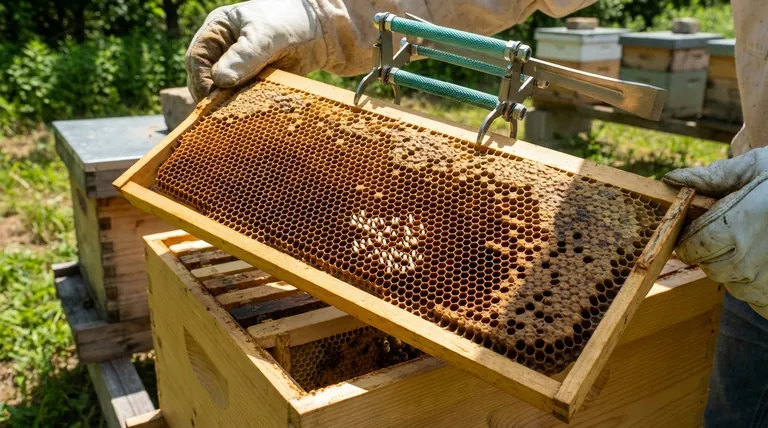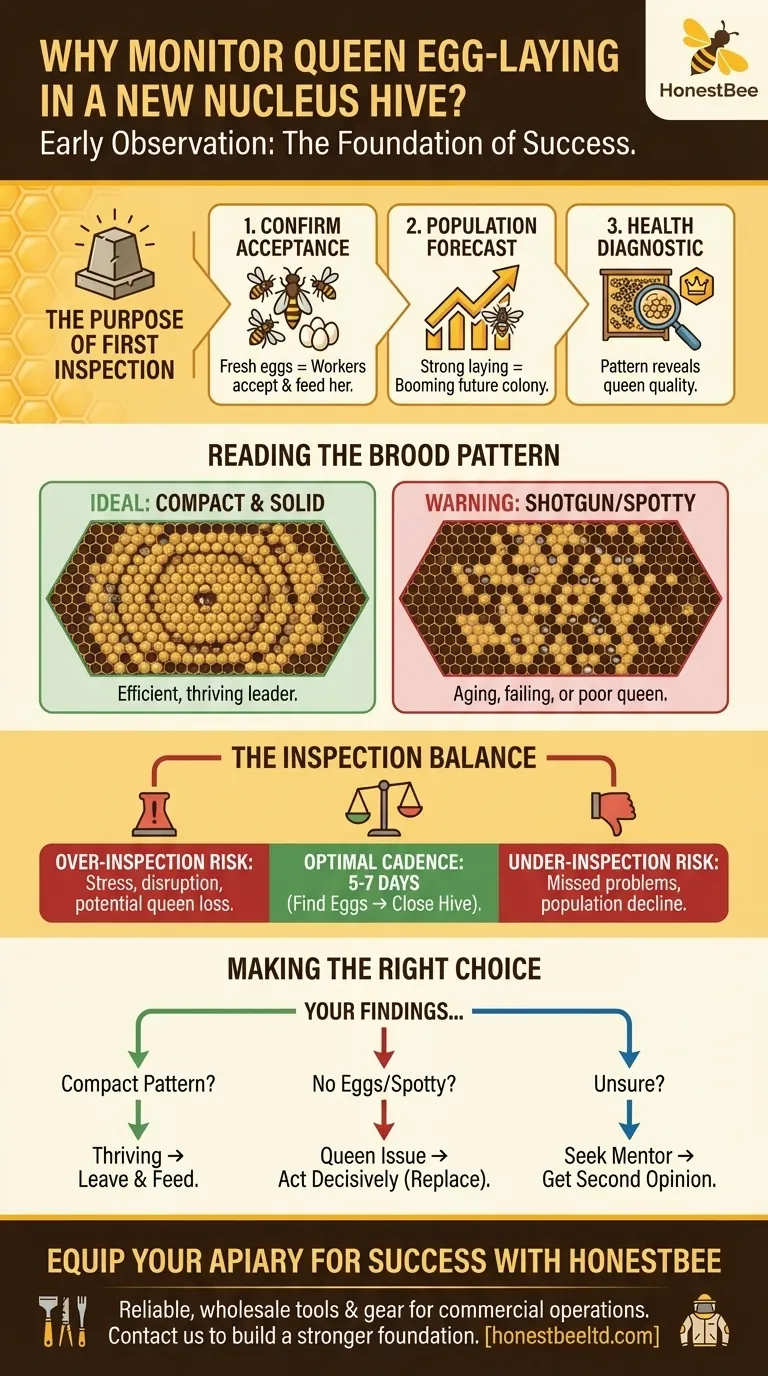In beekeeping, early observation is the foundation of success. Monitoring a new queen's egg-laying after installing a nucleus hive is the most critical first step you can take. It serves as the primary confirmation that the queen has been accepted by the colony, is healthy, and has begun the essential task of building the population that will ensure the hive's survival and future productivity.
A nucleus colony is a fragile, developing system. Checking for eggs is more than a simple confirmation of the queen's presence; it is your first and most reliable diagnostic tool to assess the fundamental health and future potential of your entire colony.

The Purpose of the First Inspection
Your initial checks are not about finding the queen herself, which can be disruptive. They are about finding evidence of her work. This evidence tells you everything you need to know about the state of the colony's leadership.
Confirmation of Queen Acceptance
The worker bees have ultimate control over the hive. If they do not accept a new queen, they will kill her, an event known as "supersedure."
The presence of freshly laid eggs is definitive proof that the workers have accepted her as their leader. They are feeding her, protecting her, and allowing her to perform her role.
A Leading Indicator of Population Growth
A healthy queen is an egg-laying machine, capable of laying up to 2,000 eggs per day during peak season.
Each egg represents a future worker bee that will emerge in approximately 21 days. A strong laying rate is a direct forecast of a booming population, which is necessary for foraging, defense, and honey production.
A Diagnostic for Queen Health and Mating Quality
The pattern of the eggs is as important as their presence. This pattern reveals the queen's quality.
A well-mated, vigorous queen will lay a single egg in the bottom-center of each cell, creating a dense, solid patch of brood. This is the sign of a productive leader.
Reading the Brood Pattern: Laying vs. Thriving
Simply finding eggs is good. Finding a compact brood pattern is the signal of a truly thriving colony. It is the key difference between a queen who is merely present and one who is proficient.
The Ideal Pattern: Compact and Solid
A high-quality queen lays eggs in a tight, concentric pattern, starting from the center of the frame and expanding outwards.
When you look at a frame, you should see a solid, concentrated area of brood. This efficient use of space ensures the brood is kept warm and fed with minimal effort from the nurse bees.
The Warning Sign: A "Shotgun" Pattern
A "shotgun" or spotty brood pattern, where eggs and larvae are scattered randomly with many empty cells in between, is a major red flag.
This often indicates an aging, failing, or poorly mated queen. The colony will struggle to grow and may eventually fail if the issue is not addressed.
Understanding the Trade-offs: The Inspection Dilemma
For a new beekeeper, knowing when to inspect is a balance between gaining information and causing disruption. Both over-inspection and under-inspection carry risks.
The Risk of Over-Inspection
Opening the hive too frequently, especially within the first few days, causes significant stress.
This disturbance can disrupt the queen's laying, lower the temperature of the brood nest, and in rare cases, cause the bees to become agitated and "ball" or kill their new queen.
The Risk of Under-Inspection
Failing to check for eggs in a timely manner means you could miss a critical problem.
If a queen is not laying after a week, the colony is "queenless." Every day without a laying queen is a day the colony's population ages and shrinks, making recovery more difficult.
A Recommended Inspection Cadence
The best practice is to wait 5 to 7 days after installation before your first inspection.
Your goal for this first check is simple: find eggs. If you see tiny, rice-like eggs standing in the bottom of the cells, close the hive immediately. Your job is done. You have confirmed she is accepted and laying. Resist the urge to search for the queen herself.
Making the Right Choice for Your Goal
Your findings during these early inspections will dictate your next steps.
- If your primary focus is colony establishment: Seeing a compact brood pattern with eggs and larvae means your queen is thriving. Your best course of action is to leave the bees alone and provide consistent feeding to support their expansion.
- If you suspect a problem: Finding no eggs after 7-10 days, or seeing a very spotty pattern, indicates a queen issue. You must act decisively to diagnose the problem and, if necessary, prepare to introduce a new queen to save the colony.
- If you are unsure of what you're seeing: Ask for help. Contacting a local beekeeping mentor or association for a second opinion is a wise move that can prevent the loss of your hive.
By learning to read the story told on the brood frames, you transition from simply owning bees to truly understanding and managing them.
Summary Table:
| Inspection Goal | What to Look For | What It Indicates |
|---|---|---|
| Confirm Queen Acceptance | Presence of freshly laid eggs | Workers have accepted the new queen as their leader. |
| Assess Queen Quality | Compact, solid brood pattern | A well-mated, healthy, and vigorous queen. |
| Identify Potential Issues | Spotty, "shotgun" brood pattern or no eggs after 7-10 days | An aging, failing, or poorly mated queen; queenlessness. |
Equip Your Apiary for Success with HONESTBEE
Your first hive inspection is a critical moment. Ensure you have the reliable, high-quality equipment needed to support your new nucleus colony without causing stress. HONESTBEE supplies commercial apiaries and beekeeping equipment distributors with the durable tools and protective gear required for confident, productive hive management.
From durable hive tools to protective suits, our wholesale-focused operations provide the foundation for successful beekeeping. Let us help you build a thriving operation.
Contact HONESTBEE today to discuss your commercial or distribution needs and build a stronger foundation for your bees.
Visual Guide

Related Products
- Professional 3-Bar Frame Grip with Integrated Hive Tool
- HONESTBEE Professional Long Handled Hive Tool with Precision Cutting Blade
- HONESTBEE Advanced Ergonomic Stainless Steel Hive Tool for Beekeeping
- Professional Dual-End Stainless Steel Hive Tool for Beekeeping
- Plastic Queen Bee Catcher Marker Tube Holder for Queen Marking Bottle
People Also Ask
- Why is proper beekeeping equipment important? Essential for Safety and Hive Health
- How do you use Frame Grips during hive inspections? Achieve Calmer, More Efficient Hive Inspections
- What are Frame Grips used for in beekeeping? Boost Your Hive Inspection Efficiency & Bee Safety
- What does every bee keeper need? Your Essential Guide to Starting Strong
- What should beginners consider when purchasing beekeeping equipment? A Guide to Essential Starter Gear



















